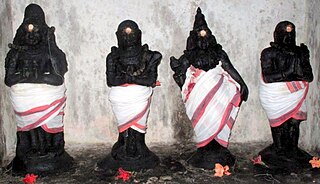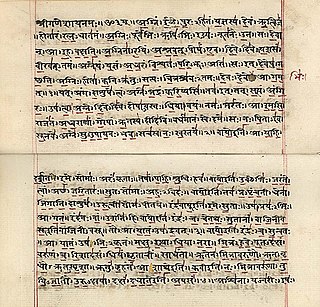Related Research Articles

The Bible is a collection of religious texts or scriptures, some, all, or a variant of which are held to be sacred in Christianity, Judaism, Samaritanism, Islam, the Baha'i Faith, and many other Abrahamic religions. The Bible is an anthology originally written in Hebrew, Aramaic, and Koine Greek. These texts include instructions, stories, poetry, and prophecies, among other genres. The collection of materials that are accepted as part of the Bible by a particular religious tradition or community is called a biblical canon. Believers in the Bible generally consider it to be a product of divine inspiration, but the way they understand what that means and interpret the text varies.

The Western canon is the body of high-culture literature, music, philosophy, and works of art that are highly valued in the West; works that have achieved the status of classics. However, not all these works originate in the Western world, and such works are also valued throughout the globe. It is "a certain Western intellectual tradition that goes from, say, Socrates to Wittgenstein in philosophy, and from Homer to James Joyce in literature".
This article contains information about the literary events and publications of 1820.

The Great Hymn to the Aten is the longest of a number of hymn-poems written to the sun-disk deity Aten. Composed in the middle of the 14th century BC, it is varyingly attributed to the 18th Dynasty Pharaoh Akhenaten or his courtiers, depending on the version, who radically changed traditional forms of Egyptian religion by replacing them with Atenism. The hymn bears a notable resemblance to the biblical Psalm 104.

Meera, better known as Mirabai, and venerated as Sant Meerabai, was a 16th-century Hindu mystic poet and devotee of Krishna. She is a celebrated Bhakti saint, particularly in the North Indian Hindu tradition. She is mentioned in Bhaktamal, confirming that she was widely known and a cherished figure in the Bhakti movement by about 1600.

Nikolaj Frederik Severin Grundtvig, most often referred to as N. F. S. Grundtvig, was a Danish pastor, author, poet, philosopher, historian, teacher and politician. He was one of the most influential people in Danish history, as his philosophy gave rise to a new form of nationalism in the last half of the 19th century. It was steeped in the national literature and supported by deep spirituality.

Tamil literature includes a collection of literary works that have come from a tradition spanning more than two thousand years. The oldest extant works show signs of maturity indicating an even longer period of evolution. Contributors to the Tamil literature are mainly from Tamil people from south India, including the land now comprising Tamil Nadu, Kerala, Eelam Tamils from Sri Lanka, as well as the Tamil diaspora.

Japji Sahib (Punjabi: ਜਪੁਜੀ ਸਾਹਿਬ, pronunciation: ) is the Sikh thesis, that appears at the beginning of the Guru Granth Sahib – the scripture of the Sikhs. It was composed by Guru Angad, and is mostly the writings of Guru Nanak. It begins with Mool Mantra and then follow 38 paudis (stanzas) and completed with a final Salok by Guru Angad at the end of this composition. The 38 stanzas are in different poetic meters.

Bernhard Severin Ingemann was a Danish novelist and poet.

Tirumurai is a twelve-volume compendium of songs or hymns in praise of Shiva in the Tamil language from the 6th to the 11th century CE by various poets in Tamil Nadu. Nambiyandar Nambi compiled the first seven volumes by Appar, Sambandar, and Sundarar as Tevaram during the 12th century. During the course of time, a strong necessity was felt by scholars to compile Shaiva literature to accommodate other works. Tiruvasakam and Tirukovayar by Manickavasagar are included as the eighth, nine parts are compiled as the ninth Tirumurai out of which most are unknown, and the tenth as Tirumandiram by Tirumular, the famous Siddhar. The eleventh is compiled by Karaikal Ammaiyar, Cheraman Perumal and others. The contemporary Chola king was impressed by the work of Nambi and included Nambi's work in the eleventh Tirumurai. Sekkilar's Periya Puranam, composed a century later, contains the life depiction of all the 63 Nayanmars. The response for the work was so tremendous among Shaiva scholars and Kulothunga Chola II that it was included as the 12th Tirumurai. Tirumurai along with Vedas and Shaiva agamas form the basis of Shaiva Siddantha philosophy in South India and Sri Lanka.

The Vedas are a large body of religious texts originating in ancient India. Composed in Vedic Sanskrit, the texts constitute the oldest layer of Sanskrit literature and the oldest scriptures of Hinduism.

Frederik Reesen Magle is a Danish composer, concert organist, and pianist. He writes contemporary classical music as well as fusion of classical music and other genres. His compositions include orchestral works, cantatas, chamber music, and solo works, including several compositions commissioned by the Danish royal family. Magle has gained a reputation as an organ virtuoso, and as a composer and performing artist who does not refrain from venturing into more experimental projects – often with improvisation – bordering jazz, electronica, and other non-classical genres.

Hans Adolph Brorson was a Danish pietist clergyman, hymn write and translator of German language hymns. He served as Bishop of the Diocese of Ribe.
The Danish Golden Age covers a period of exceptional creative production in Denmark, especially during the first half of the 19th century. Although Copenhagen had suffered from fires, bombardment and national bankruptcy, the arts took on a new period of creativity catalysed by Romanticism from Germany. The period is probably most commonly associated with the Golden Age of Danish Painting from 1800 to around 1850 which encompasses the work of Christoffer Wilhelm Eckersberg and his students, including Wilhelm Bendz, Christen Købke, Martinus Rørbye, Constantin Hansen and Wilhelm Marstrand, as well as the sculpture of Bertel Thorvaldsen.

Danish literature stretches back to the Middle Ages. The earliest preserved texts from Denmark are runic inscriptions on memorial stones and other objects, some of which contain short poems in alliterative verse. In the late 12th century Saxo Grammaticus wrote Gesta Danorum. During the 16th century, the Lutheran Reformation came to Denmark. During this era, Christiern Pedersen translated the New Testament into Danish and Thomas Kingo composed hymns. Fine poetry was created in the early 17th century by Anders Arrebo (1587–1637). The challenges faced during Denmark's absolute monarchy in 1660 are chronicled in Jammersminde by Leonora Christina of the Blue Tower. Ludvig Holberg (1684–1754), influenced by the ideas of the Enlightenment and Humanism, is considered the founder of modern Danish and Norwegian literature. Neoclassical poetry, drama, and the essay flourished during the 18th century influenced by French and English trends. German influence is seen in the verse of the leading poets of the late 18th century such as Johannes Ewald and Jens Baggesen. Other 18th century writers include the hymn writer Hans Adolph Brorson and the satirical poet Johan Herman Wessel.
Sid Bradley is an academic, author and specialist in Anglo-Saxon literature.

Johann Sebastian Bach composed the church cantata Du sollt Gott, deinen Herren, lieben, BWV 77 in Leipzig for the thirteenth Sunday after Trinity and first performed it on 22 August 1723.

The Rigveda or Rig Veda is an ancient Indian collection of Vedic Sanskrit hymns (sūktas). It is one of the four sacred canonical Hindu texts (śruti) known as the Vedas. Only one Shakha of the many survive today, namely the Śakalya Shakha. Much of the contents contained in the remaining Shakhas are now lost or are not available in the public forum.

Skanda Upanishad or Skandopanishad is one of the 108 Upanishads of Hinduism, written in Sanskrit. It is classified as a Samanya (general) Upanishad and is associated with the Krishna Yajurveda, one of the 32 listed Upanishads under it.
References
- ↑ "De levendes land" (PDF). gruntvig.dk (Grundtvigsk Forum). 2000. Retrieved 29 January 2013.
- ↑ Sven Hakon Rossel (1992). A History of Danish Literature. University of Nebraska Press. ISBN 9780803238862 . Retrieved 30 January 2013.
- ↑ "Litteratur: Lyrikantologi" (PDF). Kulturkanon. Danish Ministry of Culture. 2006. p. 47. Archived from the original (PDF) on 29 October 2013. Retrieved 30 January 2013.
- ↑ "Grundtvig-Studier 2002, pp. 153-156" (PDF). Archived from the original (PDF) on 4 March 2016. Retrieved 30 January 2013.